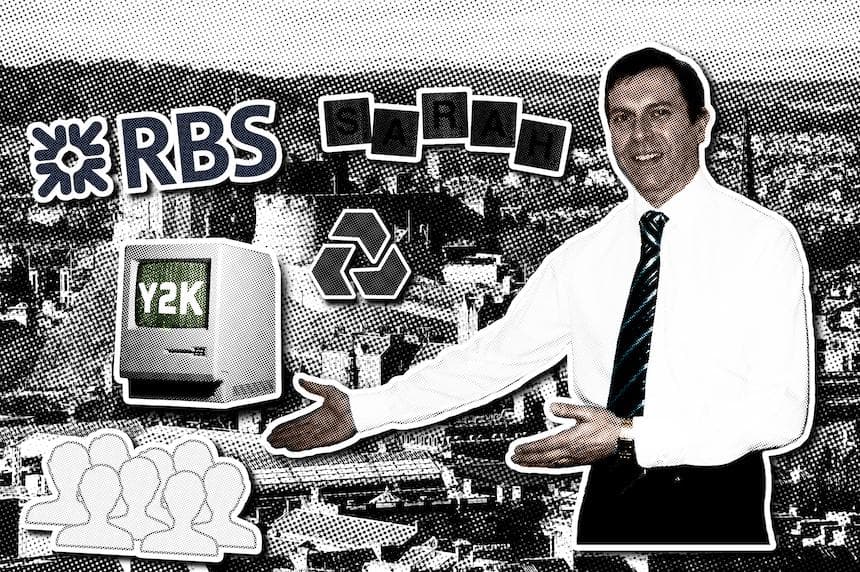A Leadership Journey: The Working Years (Part 1 - Year 2000)

The Working Years
I had the benefit of working at RBS when a lot of good things were happening, and received high quality training and experience that saw me grow from a focus on testing and release management, to managing a portfolio of projects and programmes that took up 10% of the total budget for the Development organisation. In that time, I learned that effective leadership required me to have motivation and vision, and to develop the skills to inspire and motivate others to achieve their best. I found there was huge personal satisfaction in helping people to raise their game and accomplish more than they thought possible. Now, I’d like to see if I can help more people by writing down some of the experiences, for others to pick up and consider how they can apply into their own lives.
Year 2000
I’d had a few years in supervisory then managerial roles before I arrived at RBS, all set to take up a management role – only to find it was actually a consultancy one. Nothing wrong with that really, but I prefer to get on and do things, rather than advise people what they should do.
I got my chance in 1996, when Operations Division was a year behind everyone else in preparation for Y2K, and there was an urgent drive to establish a Y2K project team. I was offered the role of Ops Division Y2K Project Manager, and – without realising it – that’s when I started on a leadership journey. It took many years of training and experience for me to understand, but I started off in that role with the two key things at the heart of leadership – motivation and vision. Motivation was the easy part – I didn’t want to be a consultant, I wanted to be delivering things. Vision took a couple of days more. I was presented with the “Group” way of doing Y2K, and it felt wrong. The approach was based around a static analysis by IBM of mainframe systems, which grouped them into what appeared to be related systems, termed Partitions. This was fine for estimating the extent of the Y2K problem, and the scale of work to fix the problems, but I felt it didn’t deal with – for me – the bigger problem: integration of changes across multiple systems. Banking systems are riddled with transactions that carry dates from one system to the next, to the next, and so on. A date problem in one system might only become evident when the transaction has gone through several other systems and gets processed days later. Then there was an artificial concept of level 1, 2 and 3 compliance, which I just didn’t buy into. I came up with a different approach that I felt tackled both, and set out my vision of how RBS could achieve compliance by 1999. I was fortunate that Stephen Brannan, newly joined RBS, had been appointed the Business Sponsor for Ops Division. He considered my proposal, and supported it. I had grouped related systems together into Partitions, and defined the order they need to be integrated with each other. I recognise now there was another aspect of leadership at play here – being comfortable with the detail. Stephen had a technical background, and took a keen interest when I dived into the detail of why the systems had to be fitted together the way I described. I took that to my counterparts representing other Divisions, explaining when I would aim to have systems ready for them to use, and when I needed to include their systems with mine.
Although I hadn’t consciously thought of it this way, I was taking another vital step in leadership, engaging those who would follow, sharing my vision, and explaining how it helped them. In December 1996, the turning point was at an offsite away day, where each Division presented their plans. I got a bit of a rebuke from Mike Low, the Head of the Central Programme, for my “emotional attachment to your own way of doing things” – but then Chas Reilly stood up to present the Retail plan, and admitted that they just couldn’t make progress with the Group approach, but he could see how the Ops approach could work for them. Kerry Dixon presented the Corporate plans and said they had always felt the Group approach didn’t work for them due to the nature of their systems, but had never had an alternative – and could now see that the Ops approach gave him that. Dave Dickerson stood up for Infrastructure and said that they had never been following the Group approach because Infrastructure didn’t work that way – but he could see how their approach would fit nicely with the Ops approach. Finally, Terry Stephens for the Central team said that there was no reason the Ops approach couldn’t be accommodated within the Central Group approach, and he’d be happy to work with me to sort out the details.
RBS followed the plan I’d laid out, and years later, Stephen Brannan introduced me to one of his peers as the only Project Manager he’d ever known who set out a plan that was still valid 2 years later. In hindsight, this was the point where everything changed for me – years later I could look back and recognise this was the first time I had the motivation and the vision, and with these, I could choose to lead the organisation down a different path. This dawned on me a few years ago when I was driving David Hinley and Kev Milne to compete in the Veterans Winton Cup. While chatting, Kev and I were amazed to learn that David is one of the co-authors and key contributors to the ITIL model and series of books, and had written about compliance approaches a few years after the industry had got past the year 2000. I explained my experience; he explained what had been described to him by one of the big IT companies, and they were uncannily similar.
